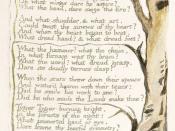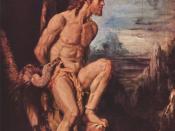William Blake wrote The Tyger as a counterpart to The Lamb. In its simplest interpretation, it may seem that The Tyger represents the bad in mankind, and The Lamb represents the good. The speaker asks the tiger, "What immortal hand or eye, could frame thy fearful symmetry?" (4) The Tyger is majestic, but also dangerous and ferocious. However, Blake shows that the tiger is scary and evil sometimes, but maybe people just can't understand the reason it was created. The tiger, like all living things, has a purpose. Blake supports this idea throughout the poem. He uses a couple of mythological allusions which, if understood, make this poem much more complex and meaningful. An allusion is made to Prometheus and the Greek god Hephaestus, who is equivalent to the Roman god Vulcan. Blake successfully incorporates these allusions to present all aspects of the tiger. He acknowledges the tiger's faults, but also includes its strengths.
This makes a very fair and bold argument.
The speaker asks "What the hand, dare seize the fire?" (8). This is an allusion to when Prometheus stole fire from Zeus and gave it to mortals. The gift of fire allowed humans to be productive and inventive. By placing this idea in The Tyger, Blake suggests that it is this darker side of humans which allowed them to progress so much in history. By looking even closer at Prometheus, many other insights can be given into Blake's reasoning behind this poem. Prometheus was punished by Zeus for giving humans fire. Zeus had Hephaestus, who is mentioned later in The Tyger, shackle Prometheus to the side of a crag. There he was doomed to spend eternity while being attacked by an eagle every day. Prometheus was fated to be punished by his own kind, the other...


